powered
by
FreeFind
Bilbao
All images link to
larger copies which open in new windows
EuskoTran
Bilbao
Tramway - Tranvia Bilbao
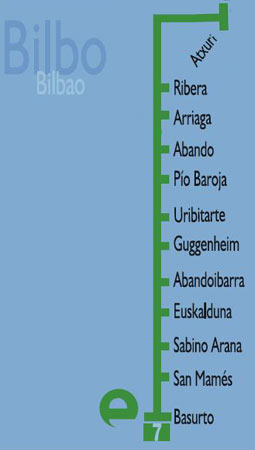 Trams returned to Bilbao
on December 18th, 2002 between Atxuri and Uribitarte, with six
stops: Atxuri – Ribera – Arriaga – Abando –
Pío Baroja – Uribitarte. Subsequent extensions were
opened to San Mamés and finally to Basurto. This constitutes
Line A, and further lines are promised.
The initial seven trams
401-407 were built by C.A.F. (Construcciones y Auxiliar de Ferrocarriles,
S.A.) and the first was delivered on 8th May 2002. The trams
are double-ended and have 4 access and exit doors on each side.
The units are 25 metres long. Each unit has been designed to
transport 192 persons, of which 50 will be seated. An eight tram
408 was later supplied by the builders CAF with all axles powered
- the first seven vehicles were powered on their end bogies only.
The units include double
air-conditioning systems as well as a centralised public address
system to broadcast music (a mixture of light classical and folk
music - irritating!), information on the next stop and special
messages. There are two electronic information panels to provide
data on the next stop and other information. Each unit has 10
security cameras with an image storage system.
Links to other systems
are shown on the
EuskoTren Route Map (PDF
File - Require Adobe Reader (700kb))
Trams returned to Bilbao
on December 18th, 2002 between Atxuri and Uribitarte, with six
stops: Atxuri – Ribera – Arriaga – Abando –
Pío Baroja – Uribitarte. Subsequent extensions were
opened to San Mamés and finally to Basurto. This constitutes
Line A, and further lines are promised.
The initial seven trams
401-407 were built by C.A.F. (Construcciones y Auxiliar de Ferrocarriles,
S.A.) and the first was delivered on 8th May 2002. The trams
are double-ended and have 4 access and exit doors on each side.
The units are 25 metres long. Each unit has been designed to
transport 192 persons, of which 50 will be seated. An eight tram
408 was later supplied by the builders CAF with all axles powered
- the first seven vehicles were powered on their end bogies only.
The units include double
air-conditioning systems as well as a centralised public address
system to broadcast music (a mixture of light classical and folk
music - irritating!), information on the next stop and special
messages. There are two electronic information panels to provide
data on the next stop and other information. Each unit has 10
security cameras with an image storage system.
Links to other systems
are shown on the
EuskoTren Route Map (PDF
File - Require Adobe Reader (700kb))
Tram
401
Tram
401 at the Guggenheim
Photo:
© Ian Boyle, 30th May 2007
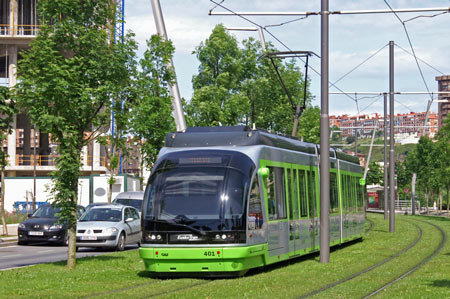
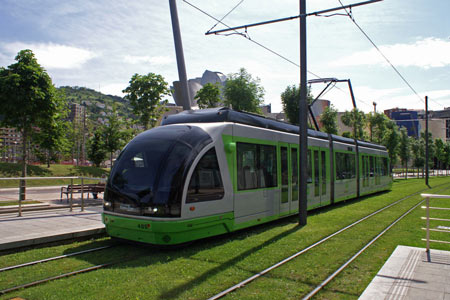
Tram
401 at Euskalduna
Photo:
© Ian Boyle, 30th May 2007
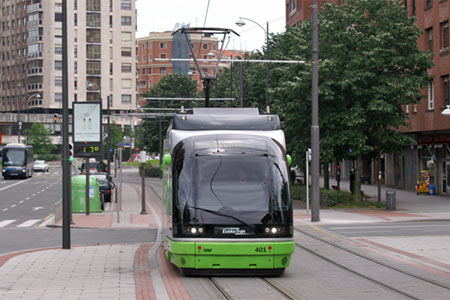
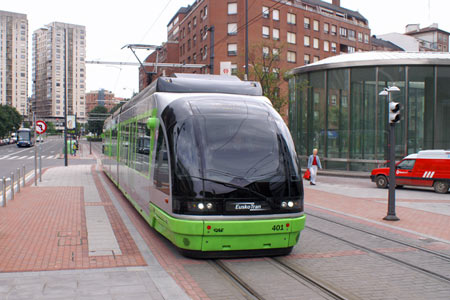
Tram
401 at the Basurto terminus
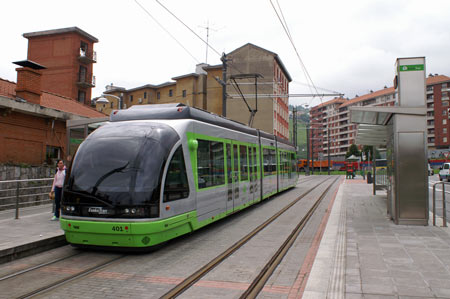
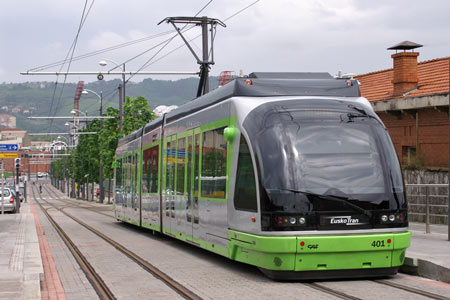
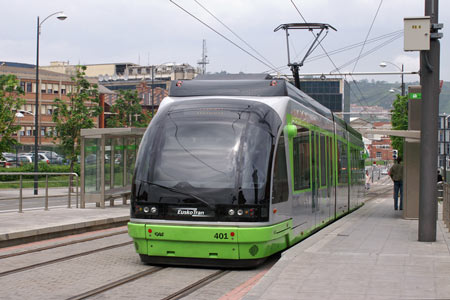
Tram
401 at Abando, where connections to the Metro, RENFE and FEVE
are possible
Photo:
© Ian Boyle, 30th May 2007
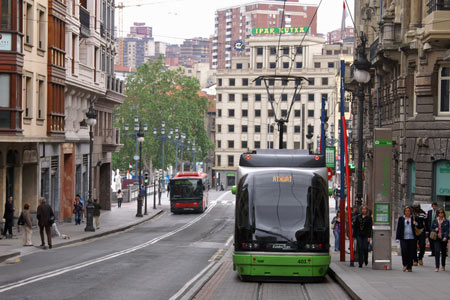
Tram
401 interior
Photo:
© Ian Boyle, 30th May 2007
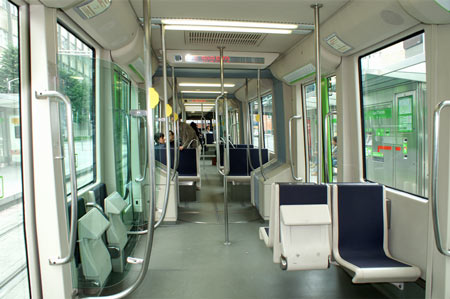
Tram
403
Tram
403 at Abando, where connections to the Metro, RENFE and FEVE
are possible
Photo:
© Ian Boyle, 30th May 2007
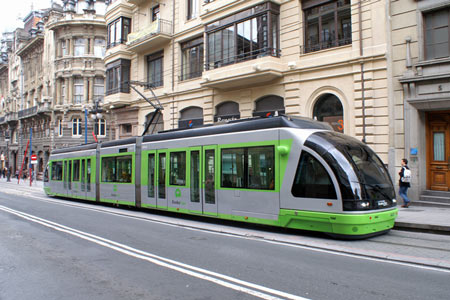 Tram
403 at Abando
Photo:
© Ian Boyle, 30th May 2007
Tram
403 at Abando
Photo:
© Ian Boyle, 30th May 2007
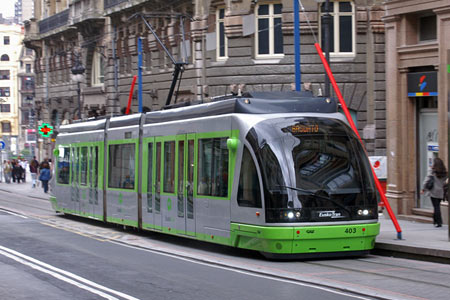 Tram
403 at Abando
Photo:
© Ian Boyle, 30th May 2007
Tram
403 at Abando
Photo:
© Ian Boyle, 30th May 2007
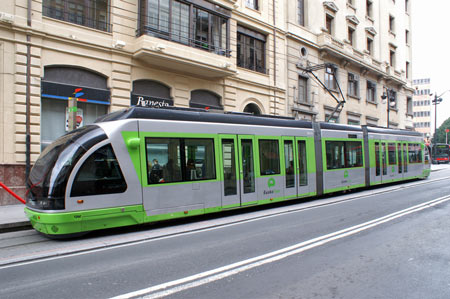 Tram
403 at Abando
Photo:
© Ian Boyle, 30th May 2007
Tram
403 at Abando
Photo:
© Ian Boyle, 30th May 2007
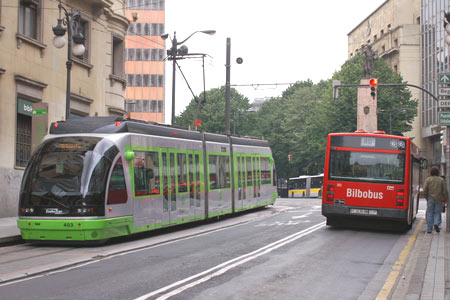
Tram
404
Tram
404 at the Guggenheim
Photo:
© Ian Boyle, 30th May 2007
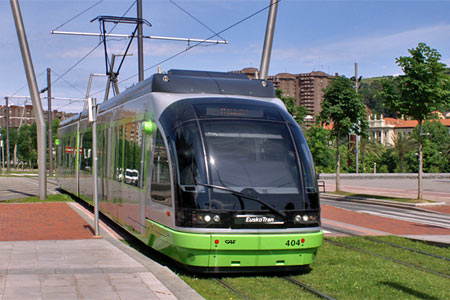 Tram
404 at the At
Photo:
© Ian Boyle, 30th May 2007
Tram
404 at the At
Photo:
© Ian Boyle, 30th May 2007
 Tram
404 at the Atxuri terminus - also the main EuskoTren terminus
Photo:
© Ian Boyle, 30th May 2007
Tram
404 at the Atxuri terminus - also the main EuskoTren terminus
Photo:
© Ian Boyle, 30th May 2007
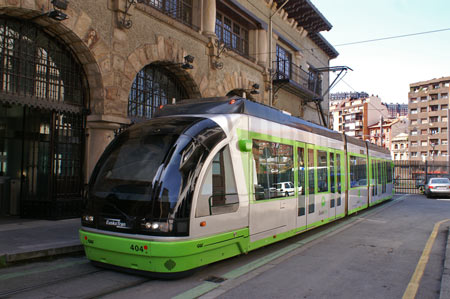 Tram
404 leaving the Atxuri terminus - also the main EuskoTren terminus
Photo:
© Ian Boyle, 30th May 2007
Tram
404 leaving the Atxuri terminus - also the main EuskoTren terminus
Photo:
© Ian Boyle, 30th May 2007
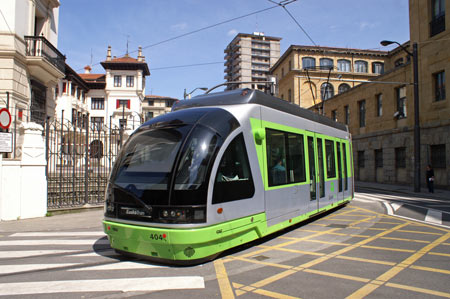 Tram
404 leaving the Atxuri terminus - also the main EuskoTren terminus
Photo:
© Ian Boyle, 30th May 2007
Tram
404 leaving the Atxuri terminus - also the main EuskoTren terminus
Photo:
© Ian Boyle, 30th May 2007
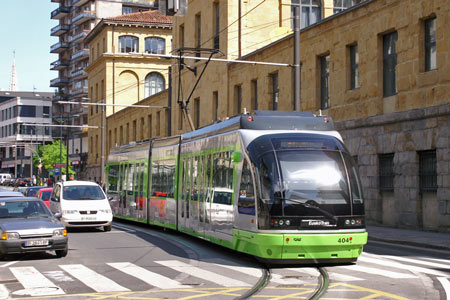 Tram
404 at the Arriaga
Photo:
© Ian Boyle, 30th May 2007
Tram
404 at the Arriaga
Photo:
© Ian Boyle, 30th May 2007
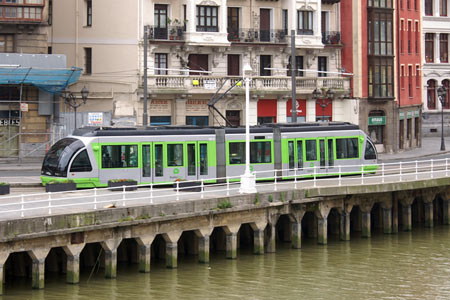
Tram
405
Tram
405 at the Guggenheim
Photo:
© Ian Boyle, 30th May 2007
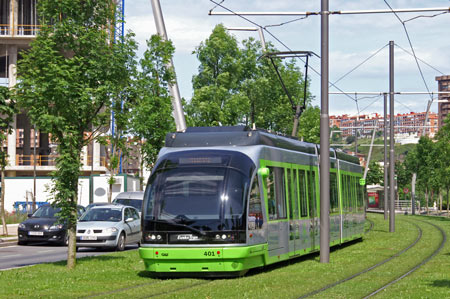 Tram
405 at the Guggenheim
Photo:
© Ian Boyle, 30th May 2007
Tram
405 at the Guggenheim
Photo:
© Ian Boyle, 30th May 2007
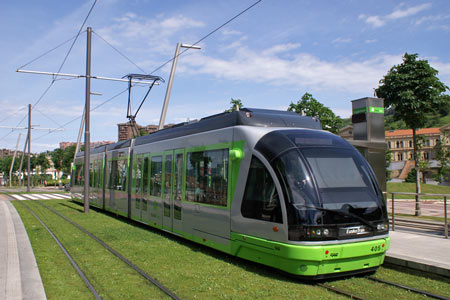 Tram
405 at the Guggenheim
Photo:
© Ian Boyle, 30th May 2007
Tram
405 at the Guggenheim
Photo:
© Ian Boyle, 30th May 2007
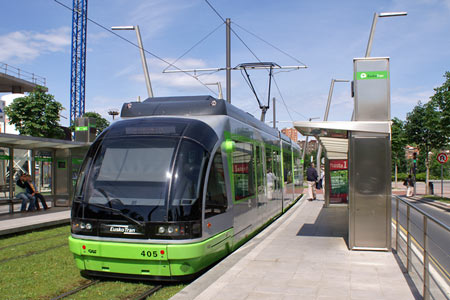
EuskoTren
EuskoTren runs two separate
metre-gauge systems from Bilbao. Lines 1 and 3 run from Atxuri
in Bilbao to Donostria (San Sebastian) and Bermeo. Line 4 is
physically unconnected from the rest of the system, and runs
from Deustu in Bilbao to Lezama. The sections were separated
in 1969 when the Matiko (Line 4) to Azbarren (Line 1 - since
closed) link was severed by a massive land slip. Some of this
link section has since been used for Metro Bilbao. There are
plans to re-link Line 4 to the rest of the system with a new
line from Casco Viejo to Etxebarri on Line 1. The EuskoTren section
from Atxuri to Etxebarri would then be replaced by an extension
to the EuskoTran tramway, partially using the trackbed.
EuskoTren has 189 km of
electrified lines between Bilbao, Donostria and Hendaye, originally
built by a number of independent companies. The three companies
which owned the sections between Bilbao and Donostria merged
to become the Compapnia de los FFCC Vascongados (FV) in 1906.
FV electrified the Bilbao-Donostria section in 1929 to increase
capacity. Initial locos were ten Belgian-built 'crocodiles' (1-10)
of 565 kW. One has been retained as a museum loco. Four box cab
locos (11-14) built by CAF joined them in 1930/31, followed by
three very similar locos (15-17) from ASEA in 1950. I will add
postcards of some of these locos soon. Four of the later locos
(12, 15-17) have been retained and were listed as operational
in 2001.
Vascongados passed to
FEVE (Ferrocarriles de Via Estrecha) in 1965, along with all
the connecting lines through to Ferrol. In 1979, the lines east
of Bilbao were taken out of FEVE's hands to be controlled by
the local Basque government, becoming ET/FV ( Eusko Trenbidaek/Ferrocarriles
Vascos) in 1982. The name was changed to EuskoTren in 1996. The
eastern section of line from Donostria to Hendaye in France was
run by SEFT (Sociedad Explotadora de Ferrocarriles y Tranvias)
became part of FEVE in 1973, also subsequently passing to ET/FV
and EuskoTren. The
Class
300 units were
built for this line, but were later replaced by Class 200 units.
A 2007 route map is available
at:
EuskoTren Route Map (PDF
File (700kb) - Require Adobe Reader). See
www.euskotren.es/euskotren2/ for the latest updates on Euskotren,
including rolling stock photos.
Historic Locos and Railcars
FV No.7
'crocodile' at Zumaya
One
of the series 1-10 built by Brown-Boveri in 1928 for the electrification
between Donostria and Bilbao
EUROFER
postcard 165 - Photo: © Santiago Mas Fatjo, 1976
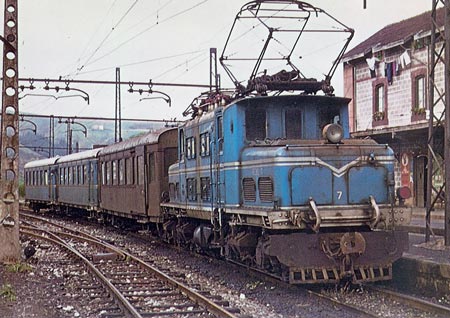 FV No.13
at Bilbao Atxuri
One
of the series 11-14 built by CAF/ASEA in 1931 the Donostria-Bilbao
route
EUROFER
postcard 243 - Photo: © Moises Martinez
FV No.13
at Bilbao Atxuri
One
of the series 11-14 built by CAF/ASEA in 1931 the Donostria-Bilbao
route
EUROFER
postcard 243 - Photo: © Moises Martinez
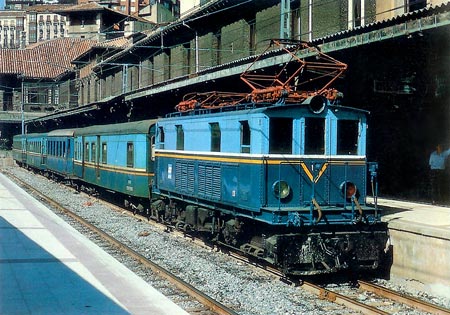 FV automotor
MCD-3 at Bilbao Atxuri
Built
by Ganz 1928 for the electrification between Donostria and Bilbao
EUROFER
postcard 191 - Photo: © Santiago Mas Fatjo, 1979
FV automotor
MCD-3 at Bilbao Atxuri
Built
by Ganz 1928 for the electrification between Donostria and Bilbao
EUROFER
postcard 191 - Photo: © Santiago Mas Fatjo, 1979
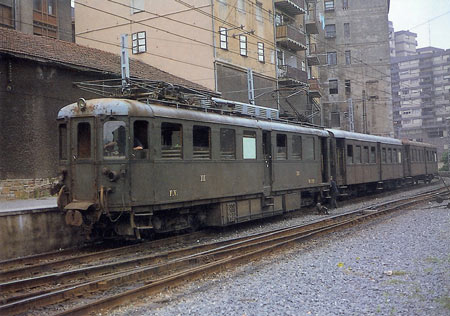 FTS
automotor and trailers at Bilbao-Plentzia
Built
1969-74 for the Bilbao suburban route to Plentzia, now Metro
Line 1
EUROFER
postcard 211 - Photo: © Javier Fano Zabala
FTS
automotor and trailers at Bilbao-Plentzia
Built
1969-74 for the Bilbao suburban route to Plentzia, now Metro
Line 1
EUROFER
postcard 211 - Photo: © Javier Fano Zabala
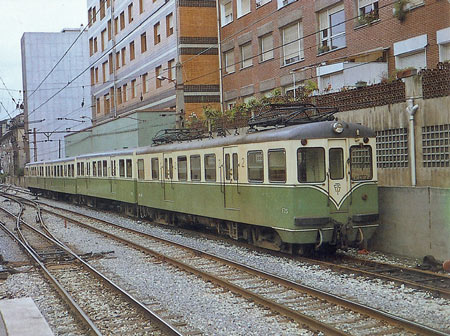
EuskoTren Class 200 EMUs
The Class 200 EMUs were
built in 1985-86 for Bilbao suburban services and the Bilbao-Plentzia
routes. When the latter line was taken over by Metro Bilbao,
some units went to Donostria-Hendaye. Twenty 3-car sets were
built by CAF.
EuskoTren
unit 204 at Lemoa, where the station undergoing a major rebuilding
program
Lines 1 and 3
from Atxuri diverge just beyond this station. This train is for
Donostria (San Sebastian) on Line 1
Photo: � Ian
Boyle, 30th May 2007
 EuskoTren
unit 216 at Bedia on Lines 1 and 3
Photo:
© Ian Boyle, 30th May 2007
EuskoTren
unit 216 at Bedia on Lines 1 and 3
Photo:
© Ian Boyle, 30th May 2007
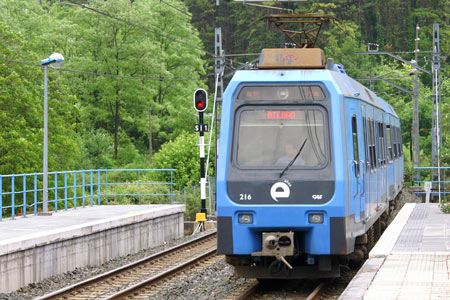 EuskoTren
unit 216 at Bolueta, where there is a connection with the Metro
Photo:
© Ian Boyle, 30th May 2007
EuskoTren
unit 216 at Bolueta, where there is a connection with the Metro
Photo:
© Ian Boyle, 30th May 2007
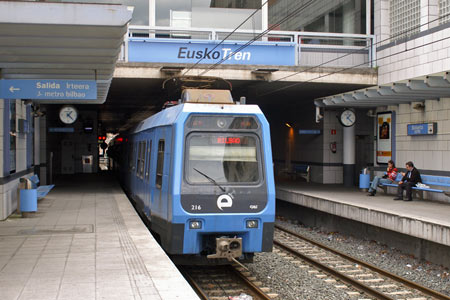 EuskoTren
unit 219 at Atxuri, the Bilbao terminus for lines 1 and 3
Photo:
© Ian Boyle, 30th May 2007
EuskoTren
unit 219 at Atxuri, the Bilbao terminus for lines 1 and 3
Photo:
© Ian Boyle, 30th May 2007
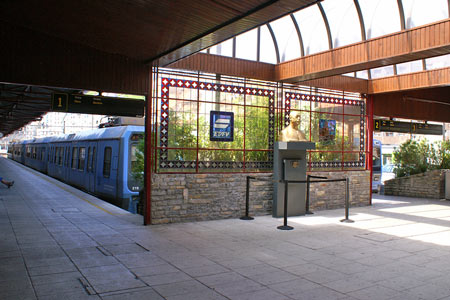 Casco
Viejo station on Line 4
Photo:
© Ian Boyle, 30th May 2007
Casco
Viejo station on Line 4
Photo:
© Ian Boyle, 30th May 2007
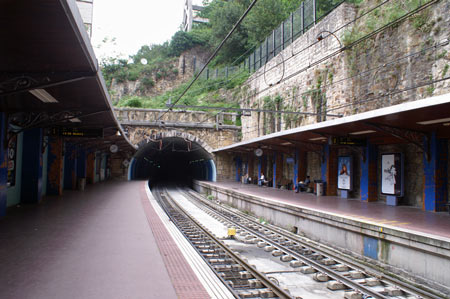 Casco
Viejo station on Line 4
Photo:
© Ian Boyle, 30th May 2007
Casco
Viejo station on Line 4
Photo:
© Ian Boyle, 30th May 2007
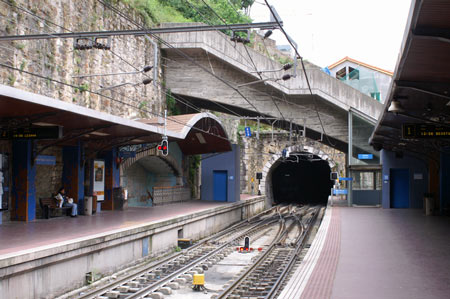
EuskoTren Class 300 EMUs
The Class 300 EMUs were
built for the Donostria-Hendaye line (known as El Topo). Twelve
2-car sets were built by CAF in 1990-91. Increasing traffic saw
them replaced by
Class
200 3-car units
in 1996, and they moved to the physically separate Deustu-Lezama
Line 4.
EuskoTren
units 306/309 at the Casco Viejo on Line 4
Photo:
© Ian Boyle, 30th May 2007
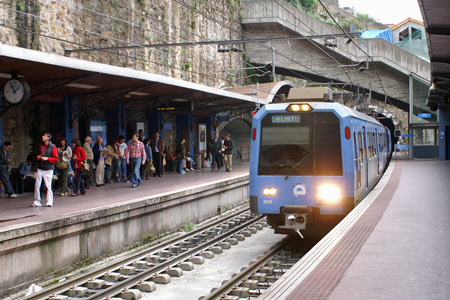 EuskoTren
units 306/309 at the Deustu terminus of Line 4
Photo:
© Ian Boyle, 30th May 2007
EuskoTren
units 306/309 at the Deustu terminus of Line 4
Photo:
© Ian Boyle, 30th May 2007
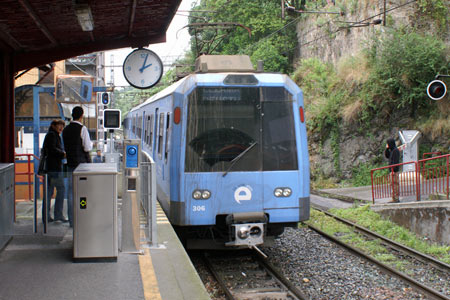 EuskoTren
units 306/309 at the Deustu terminus of Line 4
Photo:
© Ian Boyle, 30th May 2007
EuskoTren
units 306/309 at the Deustu terminus of Line 4
Photo:
© Ian Boyle, 30th May 2007
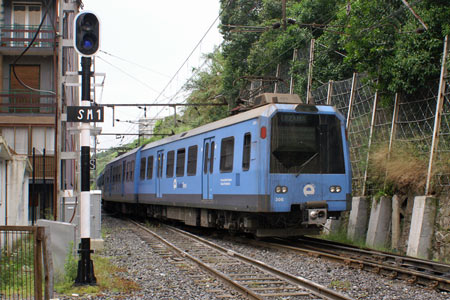 EuskoTren
units 306/309 at the Deustu terminus of Line 4
Photo:
© Ian Boyle, 30th May 2007
EuskoTren
units 306/309 at the Deustu terminus of Line 4
Photo:
© Ian Boyle, 30th May 2007
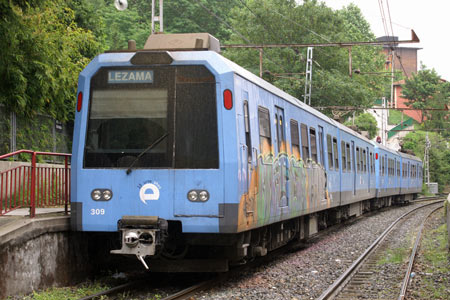 Deustu
terminus of Line 4
Photo:
© Ian Boyle, 30th May 2007
Deustu
terminus of Line 4
Photo:
© Ian Boyle, 30th May 2007
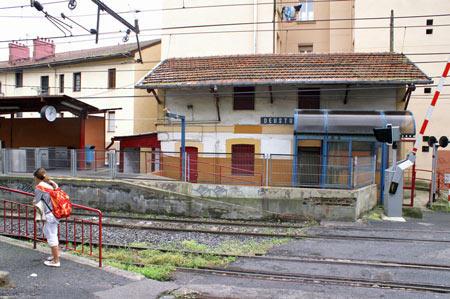
EuskoTren Class 3500
EMUs
The EuskoTren Class 3500
EMUs were built in 1977-81 for Bilbao-Donostria services. There
are fifteen 3-car sets (four have been expanded to 4-car sets).
EuskoTren
unit 3506 at Bedia on Lines 1 and 3
Photo:
© Ian Boyle, 30th May 2007
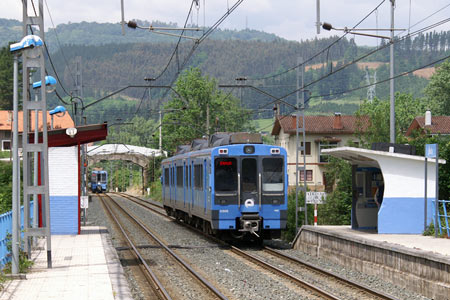 EuskoTren
unit 3506 at Bedia
Photo:
© Ian Boyle, 30th May 2007
EuskoTren
unit 3506 at Bedia
Photo:
© Ian Boyle, 30th May 2007
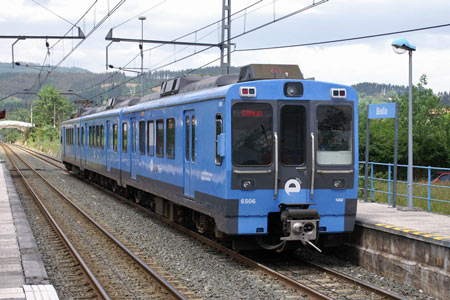 EuskoTren
unit 3506 at Bedia
Photo:
© Ian Boyle, 30th May 2007
EuskoTren
unit 3506 at Bedia
Photo:
© Ian Boyle, 30th May 2007
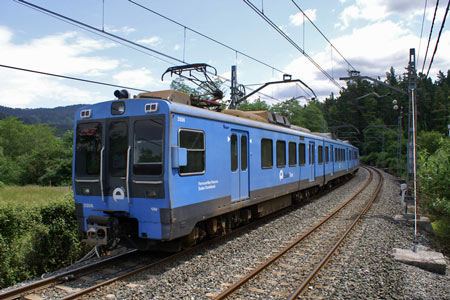 EuskoTren
unit 3506 at Bedia
Photo:
© Ian Boyle, 30th May 2007
EuskoTren
unit 3506 at Bedia
Photo:
© Ian Boyle, 30th May 2007
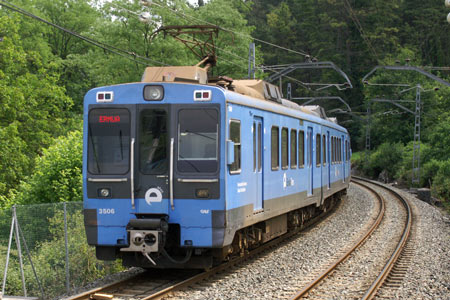 EuskoTren
unit 3509 at Lemoa on Lines 1 and 3
Photo:
© Ian Boyle, 30th May 2007
EuskoTren
unit 3509 at Lemoa on Lines 1 and 3
Photo:
© Ian Boyle, 30th May 2007
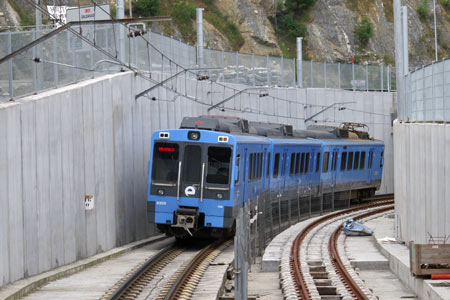 EuskoTren
unit 3509 at Lemoa on Lines 1 and 3
Photo:
© Ian Boyle, 30th May 2007
EuskoTren
unit 3509 at Lemoa on Lines 1 and 3
Photo:
© Ian Boyle, 30th May 2007